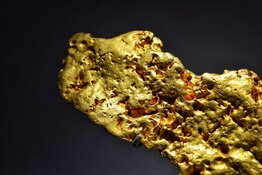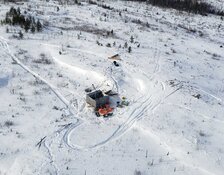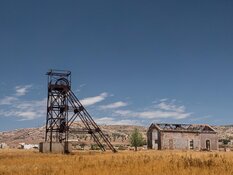David Christensen: Sure. I have a 28-year history in the precious metals markets. I started as Portfolio Manager at the Franklin Precious Metals Funds, which I managed for about a decade. At the time, of course, gold was largely out of favor. The first day I came into the fund, gold was $500/oz. (ounce). In the next decade, it proceeded to go to $250/oz. Around that time I was approached by Merrill Lynch to join the metals and mining group. I became the global head of metals and mining research, specializing in the precious metals sector and running the team. After this, I went off to industry, conducting feasibility studies and working on the corporate side as a consultant and vice-president of corporate development for a couple of companies. I have been a director of mining companies as well, including Hecla Mining Co. (HL:NYSE), and am presently on the board of the Denver Gold Group.
I was approached by the ASA board about five years ago to take over the management of the closed-end fund, which is one of the oldest precious metals funds in the world. It was formed in 1958 by Charles Engelhard, who was also the founder and chairman of Engelhard Industries Inc., one of the largest precious metals refineries in the world.
TGR: Where was that headquartered?
DC: Engelhard was in London at the time. The fund was listed in New York as a way for American investors to invest in the growth of the industry, which, at that time, was the development in the Witwatersrand Basin in South Africa. This was the late 1950s when miners were developing all the South African gold fields. At that time, there were no international settlement facilities, no ADR (American Depository Receipts) markets, etc. So, ASA, which stood for American South African, was the only foreign-registered, closed-end fund listed on the New York Stock Exchange (NYSE). As a result, a number of exceptions were made for the fund. It listed and raised $28 million (M) in 1958. Ever since, it has been one of the largest precious metals funds in the industry. ASA has always been a very long-term investor, seeking high-quality companies with strong management teams. When the market was out of favor, we still had the resources to help finance the industry and provide capital to companies in need of capital. Our long-term perspective is our advantage.
TGR: ASA must represent some of the most long-term precious metals bulls on the planet, particularly in the U.S.
DC: We have shareholders who have been in the fund since 1960. We have held some of our holdings since 1958. The annual dividend income of some of our holdings exceeds our cost basis by a factor of 4. It's like buying a share at a nickel and getting two dimes in income every year. These are benchmark companies that everyone knows: AngloGold Ashanti Ltd. (AU:NYSE; ANG:JSE; AGG:ASX; AGD:LSE), Gold Fields Ltd. (GFI:NYSE), Impala Platinum Holdings Ltd. (IMP:JSE) and Anglo American Plc. (AAUK:NASDAQ).
TGR: Are there any restrictions about where these companies are issued?
DC: No. The fund was originally South African based. In 2004, we moved to Bermuda and re-registered the company because of tax changes in South Africa. By moving, we protected our shareholders and became a globally diversified, precious metals fund. So today, the South African gold portion of the portfolio comprises just under 10% of the overall holdings. There is about 10% in South African platinum companies, and the rest are global metals and mining companies.
TGR: Are there several funds within ASA, or is it just one fund?
DC: It's one fund, one task, and what is unique is we are not an external manager. ASA is more akin to an operating company than a fund. No management fee goes out. We keep expense ratios and operating expenses low for our shareholders. The greater the total return, the happier the board is with our performance. But there is no management fee where we are stripping 100 basis points out of the fund each period. Our income statement shows every line item and every expense.
TGR: Interesting. So, how is the fund weighted in terms of metals?
DC: At the moment, it's about 86% gold, 10% platinum and palladium with the balance in silver, diamonds and diversified.
TGR: But no base metals.
DC: About 4% of the portfolio is in Anglo American, a diversified miner, which represents our largest base metals exposure. It's a company we think is inexpensive and undervalued and we like its prospects in the long term.
TGR: So it's really geared toward gold.
DC: It's effectively a gold fund. In a rampant bull market, it may tend to slightly underperform. But we are trying to look through to the long term and not rely on gold going $1,900/oz. as opposed to $1,800/oz. to pick up that last little incremental basis point. Instead, we look forward five or 10 years to companies that we think are going to deliver long-term growth with a strong management team rather than speculate on the day-to-day movement of the gold price.
TGR: I see you are headquartered in San Mateo, Calif., which is an unusual place to be for a gold fund. Why?
DC: Why not?
TGR: I like that answer.
DC: For 50 years, ASA was decentralized with management in New Jersey, Buffalo, South Africa, Bermuda and Washington. We had directors scattered around the world. Two years ago we consolidated in one location and it really refined the focus. We have grown the management team and added a research analyst.
Plus, three very large gold funds are also in the Bay Area. As a consequence, a lot of companies come through the area on a regular basis. At least four companies of significant size walk through the door every single week. Anyone from Goldcorp Inc. (G:TSX; GG:NYSE) and Barrick Gold Corp. (ABX:TSX; ABX:NYSE) to some of the more junior companies are regular visitors to the office. The other benefit of our Bay Area location is that we are near an international airport. I can get to Australia overnight. I can be in South Africa the next day. I can be in New York for a meeting very quickly. It is a very strategic location. And frankly, the weather is a lot better than in New York.
TGR: Or Toronto.
DC: Or Toronto. I lived in Toronto for two years but my family ultimately preferred California.
TGR: What is the value in today's dollars in the fund?
DC: Today, the fund has approximately $675M in assets. Because it is a closed-end fund, it tends to trade at a discount to its net asset value (NAV) as traded on the NYSE. You can buy a portfolio that in some ways is similar to other open-end gold funds, but pay a 10% discount by buying shares of ASA. All things being equal, you’re buying the same assets on sale.
TGR: Also, a lot of us believe that a lot of equities in some of these major funds—and we'll talk about the equities in a minute—are undervalued, so you have that leverage as well.
DC: It's actually kind of frustrating. The senior gold companies—and many of the juniors—have actually underperformed the gold price in the last year. In fact, our own discount has gone from 1% to 10% in the last 10 months. We think the stocks in our portfolio are undervalued. I have an option today as a portfolio manager to go out and add to Barrick, or Tahoe Resources Inc. (THO:TSX) or Alacer Gold Corp. (ASR:TSX), but I can also buy my own portfolio at a discount. In the last couple of weeks, we have actually been very active in the marketplace, buying our own shares. We put out a press release two weeks ago, announcing that we were actively repurchasing shares. We acquired 100,000 shares in a single block and have continued to be active in the market ever since.
TGR: Let's talk about the equities. What is your asset allocation between seniors, juniors and small caps?
DC: The fund can go anywhere in the asset capitalization spectrum we want. Today, the portfolio's top 10 holdings are largely the senior gold companies. The next 20 holdings really drive the performance of the fund. One of those is Alacer Gold Corp. with about 3% of assets. Alacer is a $3B market cap company that was formed through the combination of two companies: Anatolia Minerals (ANO:TSX) and Avoca Resources. It is a very liquid company with assets in Australia and Turkey. It has an exceptionally strong management team and has been doing a very good job of delivering returns for shareholders.
Another one that would fit this bill, which has been a very strong company for ASA, is Tahoe Resources. Headquartered in Reno, Nev., it has one large development asset in Guatemala. As a former silver mining company board member, I have seen a lot of silver assets and believe that this is truly one of the richest silver projects. In fact, a number of good companies in this industry have lost management to Tahoe simply because of the project's attractiveness.
TGR: It has had an impressive growth profile for such a new public company.
DC: It doesn't have its permits yet and it's in Guatemala. But if you look at the industry today, where a lot of the go-to, hot stocks we are seeing promoted are in West Africa, Asia and Latin America, frankly Guatemala is just not that bad. To put the risk in perspective, ask which country you would rather go to on a family vacation? Would you rather take them to Burkina Faso or Guatemala?
TGR: Having been to Guatemala, I'd pick Guatemala.
DC: Pretty much a no-brainer.
TGR: What are some of the other gold-focused companies that have performed well?
DC: Over the last couple of years, the portfolio took a very significant position in NovaGold Resources Inc. (NG:TSX; NG:NYSE.A). In December 2008, after the market crash, gold stocks decreased in valuation by 50%, and no capital was available in the marketplace. As a closed-end fund not subject to shareholder redemptions, ASA was able to step in and help, with a syndicate, to provide capital to save NovaGold when it got into trouble. That position became a phenomenal performer.
TGR: We have seen an impressive recovery with that stock.
DC: NovaGold stock went from $.50 to $14, and now it's trading at about $7/share. It was a situation where we saw a significantly undervalued asset and were able to step in with some liquidity when it was appropriate. We have trimmed our position but remain happy with our current involvement.
TGR: Isn't NovaGold looking at producing in early 2013? It has a lot of blue sky with the whole bulk tonnage open pit operation.
DC: The reduction of ASA's position in NovaGold wasn't because of fundamentals for the company. The position had simply grown to be one of our top 10 and it was time to take some money off the table and reallocate it to what might be the next opportunity in the sector.
TGR: Let's talk about the next opportunity.
DC: One of the reasons we attend these conferences is to search for those next opportunities. We have seen a number of interesting stories in the last couple of days, which have the potential to be very significant companies over the next few years. A lot of them, interestingly, are recovery situations where they have tripped in the last two years and as a consequence, underperformed. We think some are poised to turn around and start improving. Also, for the first time in probably 10 years, the seniors look to be a very good value. Juniors have gone from trading at, say, 60%–70% net present value (NPV) to 1.3-1.4 times. They have become expensive. In fact, we are not seeing a lot of the seniors chasing the juniors or the mid caps today simply because the valuations have gotten out of whack.
TGR: And the mergers and acquisitions (M&A) activity we are seeing is probably less robust than we were expecting.
DC: I would call most of what we are seeing opportunistic M&A. It is based on finding two assets next to each other and putting them together. That is different than cherry-picking new assets.
TGR: Would the recent acquisition of Agnico-Eagle Mines Ltd. (AEM:TSX; AEM:NYSE) merging with Grayd Resource Corp. (GYD:TSX.V) be an example?
DC: That's a perfect example of an opportunistic situation where there is a synergy of assets as opposed to company A going out and finding a new log to put on the fire. But the seniors, like Barrick, GoldCorp and, ironically, the South Africans are doing an exceedingly good job in terms of value right now. Many of them are trading at attractive discounts. Over the last few weeks, we have started to see some seniors outperform the juniors, which is very unique.
TGR: And that presents an opportunity for the typical U.S. investor that is unusual because it derisks the entry into the precious metals space.
DC: Very much so. You are buying Barrick as a diversified portfolio of 50 assets or more. No single asset is going to make or break this company, as opposed to a junior operating a single asset that could vanish tomorrow. A senior is just a less speculative investment. They are also going to throw off significant cash for the next couple of years. Many of them are trading at six times cash flow. I mean, these are unbelievable values.
TGR: It's unusual to think about investing in a mining stock as an income stock. We just haven't seen that with many of the seniors over the years.
DC: The industry traditionally had a dividend-income yield of about 0.6%. Today, it's approaching 2% and it will probably head toward 3%. Dividend distributions are becoming increasingly strong. Part of this is because of the massive increases in cash flow these companies are seeing. It's funny how things change. In the late 1980s, I can remember when people bought the South African gold stocks when they were yielding 12%, 13%, 14%, and sold them when they got to 3%. Today, they are hoping to get back to 3%. At that time, individual assets distributed 100% of their cash flow. Today, consolidated companies invest to regenerate growth. Times have changed, but it's good to see a return of the dividend yields. Over the last nine months, we have seen approximately a 70% increase in our projected income to the portfolio.
TGR: Thank you so much, David. We really appreciate you sharing these ideas.
David Christensen is president, CEO and CIO of ASA Gold and Precious Metals Ltd. He joined the company in 2007 as vice president of Investments and was promoted to his current positions in 2009. Prior to joining ASA, Christensen worked with Gabriel Resources, a junior gold company, most recently as vice president of Corporate Development. He worked on the feasibility study and financing plans for the development of the Rosia Montana project. From 2002-2003, Christensen was director of Fundamental Equity Research focusing on the North American mining industry at Credit Suisse First Boston. At CSFB, he earned a StarMine ranking for some of the most accurate earnings estimates. Prior to CSFB, Christensen worked at Merrill Lynch, ultimately as first vice president, global coordinator of Mining Research and Precious Metals. During this time, he was consistently ranked by the Wall Street Journal and Reuters as one of the precious metals industry's best analysts. He began his career at the Franklin Templeton Group. Christensen has served as director of the Denver Gold Group since 2010. He also served as director of Hecla Mining Company and chairman of Agnico-Eagle Delaware (LLC), a financing subsidiary of Agnico-Eagle Mines Ltd. Christensen received his B.S. in Business Administration at California State University, Chico.
Want to read more exclusive Gold Report interviews like this? Sign up for our free e-newsletter, and you'll learn when new articles have been published. To see a list of recent interviews with industry analysts and commentators, visit our Exclusive Interviews page.
DISCLOSURE:
1.) Sally Lowder of The Gold Report conducted this interview. She personally and/or her family own shares of the following companies mentioned in this interview: None.
2.) The following companies mentioned in the interview are sponsors of The Gold Report: Grayd Resource Corp., NovaGold Resources and Gold Fields.
3.) David Christensen: I personally and/or my family own shares of the following companies mentioned in this interview: ASA Gold and Precious Metals Limited and Hecla Mining Company. I personally and/or my family am paid by the following companies mentioned in this interview: ASA Gold and Precious Metals Limited.










































